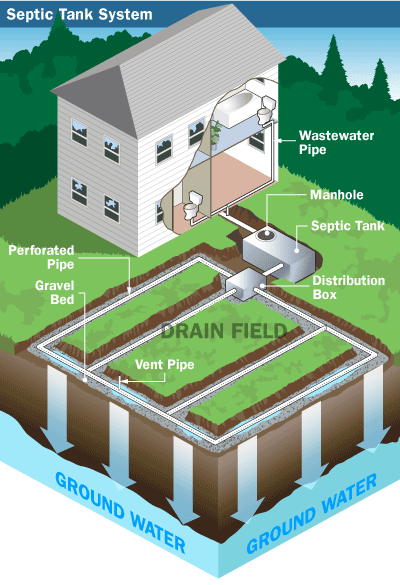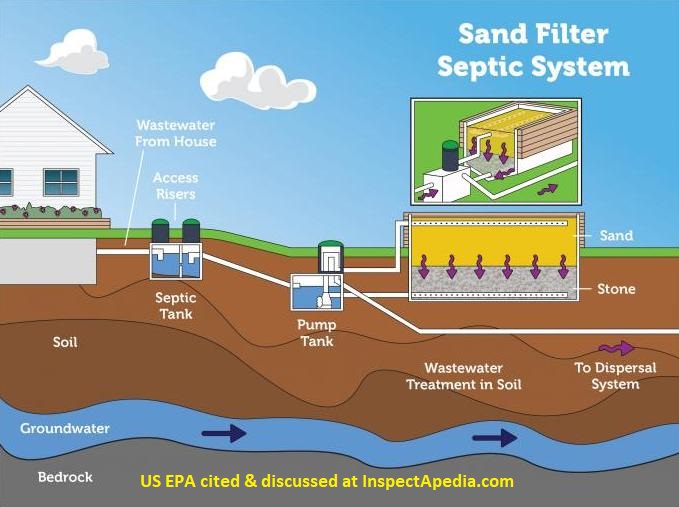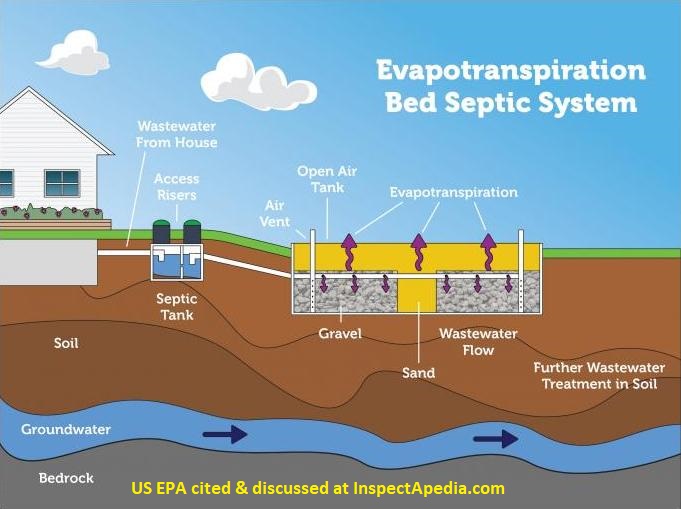8 Types of Septic Systems
Listed below are 8 different types of septic systems available for installation and we are going to discuss the purpose of each.
Conventional System
A conventional system is usually found at single family homes or small businesses. They consist of a septic tank, an underground infiltration system or a gravel drain field, and a geofabric later that protects the clean drain field from other contaminants.
This system has been around for a long time. With the gravel design, effluent (waste) flows from the septic tank to an underground trench just deep enough for the piping and is filled with stone or gravel, which acts as a filter. The effluent then flows through the soil where is it treated by microbes.
This system has the benefit of familiarity by most septic companies, which makes it easier to repairthan some of the newer systems. The downside of this system is the larger footprint which makes it difficult to installon smaller lots.

Chamber System
A chamber system uses no gravel and can be manufactured with recycled materials which offer a significant savings in carbon footprint. This system offers an increase in ease of delivery and construction and is primarily used when the water table is high, significant ground water saturation most of the year, gravel is scarce, or in an area where technologies such as plastic chambers are readily available. This system consists of a series of connected chambers which are filled with soil. The septic pipes move wastewater from the house to the septic tank and then into the chambers. In the chambers, the wastewater drains through the soil and is then treated by microbes before it flows to the groundwater.
A benefit to this system is the ability to use it in areas with high water tables or high saturation. A down side is due to the number of chambers, there is risk for added maintenance.
Aerobic Treatment System
An aerobic treatment system (aka: aerobic treatment unit) infuses the wastewater with oxygen to help add nutrients to the wastewater. This additional oxygen increases the natural bacterial activity, which provides additional treatment for the nutrients in the effluent. On occasion, some aerobic treatment systems will have a pretreatment tank and a final treatment tank to further the reduction of pathogen levels.
Some benefits of this system is that they can be used on lots with less acreage, areas with high water tables, or inadequate soil conditions.
Drip Distribution System
The drip distribution system does not require the traditional gravel based drain field, rather uses a system of drip tubing buried just 6 to 12 inches below the soil surface. This system requires a dose tank which is rather large. This tank is used to hold the wastewater after it passes through the septic tank. It then slowly releases the wastewater to the drip system in a timed manner to keep the area from over flowing.
Some benefits of this system is that is does not require a gravel based drain field, and it is easier and more convenient when it comes to maintenance since a lot of digging is alleviated. Some down sides of this system include the large dose tank, as well as the fact that this system has to be hooked up to electricity which increases expense and maintenance.
Sand Filter System
Sand filter systems allow the effluent to flow from the septic tank to a pump chamber, then to a sand filter. The sand filter is often a concrete box filled with sand matter or PVC-lined. The effluent is pumped under low pressure through the pipes and is treated as it flows through the sand. After the wastewater is treated, it is distributed to the drain field and released.
Benefits to the sand filter system are that it is good for sites with a high water table or close to bodies of water, and sand provides great treatment for nutrients. A down side is that they are more expensive than a conventional system and require frequent maintenance.

Evapotranspiration System
Evapotranspiration system's drain fields are closed in a waterproof field filled with layers of gravel and sand. This is very different from all of the other systems, as the wastewater of this system never filters into the soil. The effluent enters the drain field and evaporates into the air.
The benefits of this system are great as it is easy to use, easy to install, and has low maintenance. However, the downside is that it has to be in an environment that is warm and dry so that the wastewater evaporates quickly. If there is too much humidity, rainwater, or snow, the system will not function properly.

Mound System
A mound system is constructed by creating a large sand mound which is used as the drain field. The wastewater flows from the septic tank to a chamber where it is pumped into the mound in prescribed doses. It is then sifted by the sand and eventually drains into the soil. The mound system is typically used in areas where the soil depths are shallow, there is high ground water, or a shallow bedrock. It is also used in rural areas where there is plenty of land but a lack of good soil drainage.
A benefit to the mound system is that it can be a good solution for certain soil conditions. The downside is that it requires a substantial amount of space and periodic maintenance.

Cluster/Community System
A cluster/community system is a decentralized wastewater system that collects wastewater from multiple homes or buildings. The system distributes the wastewater to a treatment and dispersal system which is located near the homes or buildings. These systems are typically found in places like rural subdivisions.
A benefit to this system is it is great for smaller lots that are close together with other small lots. It provides a great septic solution and is more efficiently maintained due to overlapping parts. A downside to this system could be having one system negatively effected by another due to improper maintenance or usage.
Henson Septic Services offers Northeast Georgia homeowners septic system pumping services. Our technicians rank among one of the most experienced within the Northeast Georgia region and accommodate our customers with emergency response 24 hours/7 days a week.
If you haven’t had your septic system pumped recently or just want some professional advice as to the health of your tank, give Henson Septic Services a call at 1-706-949-1460. We’re also available through email at hensonsepticservices@gmail.com. For expert septic system maintenance, inspection, and repair, we’re the answer for Northeast Georgia homeowners!
